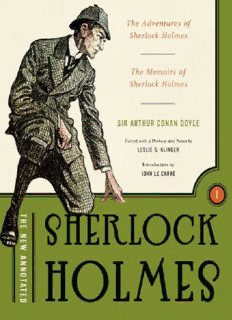Table Of ContentT S A C D
O IR RTHUR ONAN OYLE
“Steel true, blade straight”
CONTENTS
Preface
Introduction by John le Carré
The World of Sherlock Holmes
THE ADVENTURES OF SHERLOCK HOLMES
A SCANDAL IN BOHEMIA
THE RED-HEADED LEAGUE
A CASE OF IDENTITY
THE BOSCOMBE VALLEY MYSTERY
THE FIVE ORANGE PIPS
THE MAN WITH THE TWISTED LIP
“A ROSE BY ANY OTHER NAME . . .”
THE ADVENTURE OF THE BLUE CARBUNCLE
A WINTER’S CROP
THE ADVENTURE OF THE SPECKLED BAND
“IT IS A SWAMP ADDER! . . . THE
DEADLIEST SNAKE IN INDIA.”
THE GUNS OF SHERLOCK HOLMES AND
JOHN H. WATSON, M.D.
THE ADVENTURE OF THE ENGINEER’S THUMB
THE ADVENTURE OF THE NOBLE BACHELOR
THE ADVENTURE OF THE BERYL CORONET
THE ADVENTURE OF THE COPPER BEECHES
THE MEMOIRS OF SHERLOCK HOLMES
SILVER BLAZE
“. . . AND THE CALCULATION IS A SIMPLE
ONE”
“I STAND TO WIN A LITTLE ON THIS NEXT
RACE . . .”
THE CARDBOARD BOX
THE YELLOW FACE
THE STOCK-BROKER’S CLERK
THE “GLORIA SCOTT”
THE MUSGRAVE RITUAL
THE RITUAL OF THE MUSGRAVES
THE REIGATE SQUIRES
THE CROOKED MAN
THE INDIAN MUTINY
THE RESIDENT PATIENT
THE TEXT OF “THE RESIDENT PATIENT”
THE GREEK INTERPRETER
MYCROFT HOLMES
THE NAVAL TREATY
THE FINAL PROBLEM
REVISIONS OF “THE FINAL PROBLEM”
Chronological Table: The Life and Times of Sherlock
Holmes
Other Annotated Books
Also by Leslie S. Klinger
PREFACE
I
N 1968, WHEN I was supposed to be engrossed in
law school studies, I received a gift of William S. Baring-
Gould’s The Annotated Sherlock Holmes, published the
previous year. This magical pair of volumes entranced
me and led me back to the stories that I had enjoyed when
I was young(er) and had subsequently forgotten. More
importantly, the books introduced me to the idea of
Sherlockian scholarship, the “game” of treating the
stories as biography, not fiction. In later years, as I avidly
collected things Sherlockian, I dreamed that someday I,
too, would produce an annotated version of the Canon.
Baring-Gould’s Annotated Sherlock Holmes remained in print for
more than twenty-five years and became the cornerstone of every
Sherlock Holmes library. Yet it had its idiosyncrasies, with the stories
arranged in the controversial chronological order created by Baring-
Gould and with footnotes that embraced, in many cases, Baring-
Gould’s personal theories regarding the life of Holmes. Sadly, Baring-
Gould did not live to see publication of his greatest work, and as a
result, occasional errors were not corrected. In contrast to the Baring-
Gould edition, the Oxford Sherlock Holmes, published in 1993,
presented the stories in nine volumes (as they were originally
published in book form), but the scholarly notes largely ignored
Sherlockian scholarship, concentrating more traditionally on analysis
of Conan Doyle’s sources.
I set out to create for this edition an annotated text that reflects the
spectrum of views on Sherlockian controversies rather than my own
theories. In addition, this work brings current Baring-Gould’s long-
outdated survey of the literature, including references to hundreds of
works published subsequently. Recognizing that many of the events
recorded in the stories took place in England over 100 to 150 years
ago, it also includes much background information on the Victorian
age, its history, culture, and vocabulary. For the serious scholar of the
Sherlockian Canon, there is an extensive bibliography at the end of
Volume II. Chronological tables, summarizing the key dates in the
lives of Holmes, Watson, and Conan Doyle and major world events,
are set forth at the end of each volume. I have avoided “lawyerly”
citations of the works consulted, but full citations may be found in the
nine volumes of my Sherlock Holmes Reference Library, published by
Gasogene Books.
Thirty-seven years have passed since publication of Baring-Gould’s
monumental work, and the world of Sherlock Holmes has grown
much larger. This edition was created with the assistance of new
resources that now exist for the serious student—Ronald L. DeWaal’s
The Universal Sherlock Holmes, Jack Tracy’s Encyclopaedia
Sherlockiana, Steve Clarkson’s Canonical Compendium, and scores
of other handbooks, reference works, indexes, and collections, many
in computerised format. It also reflects the aid of a new tool—the
Internet, which makes accessible immense quantities of minute detail.
This is not a work for the serious student of Arthur Conan Doyle.
While Doylean scholarship is vitally important, the reader of these
volumes will not find reference to the literary sources of the stories or
to biographical incidents in the life of Sir Arthur that may be reflected
in the Canon. I perpetuate the gentle fiction that Holmes and Watson
really lived and that (except as noted) Dr. John H. Watson wrote the
stories about Sherlock Holmes, even though he graciously allowed
them to be published under the byline of his colleague and literary
agent Sir Arthur Conan Doyle.
To keep this work from approaching the length of a telephone book,
it is published in three volumes: The first two volumes consist of the
fifty-six short stories that appeared from 1891 to 1927 (Volume I
containing the stories collected in the volumes called The Adventures
of Sherlock Holmes and The Memoirs of Sherlock Holmes, Volume II
containing the stories collected under the titles The Return of Sherlock
Holmes, His Last Bow, and The Case-Book of Sherlock Holmes); the
third volume (to be published in 2005) presents the four novels, A
Study in Scarlet (1887), The Sign of Four (1890), The Hound of the
Baskervilles (1902), and The Valley of Fear (1915). All in all, here is
the complete record of the career of Mr. Sherlock Holmes. For the
first-time reader of these tales, my best advice is to plunge
immediately into the stories, skipping the introduction. Whether this is
your first reading or your fifty-first reading of the Canon, I wish you
joy in the experience, and I hope that you find that this edition
enriches it.
LESLIE S. KLINGER

